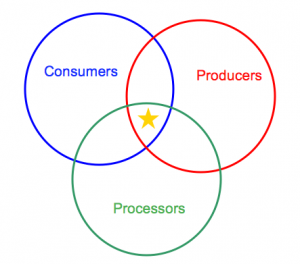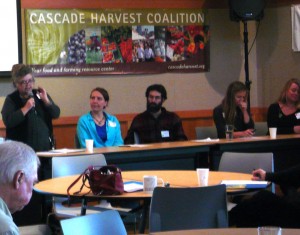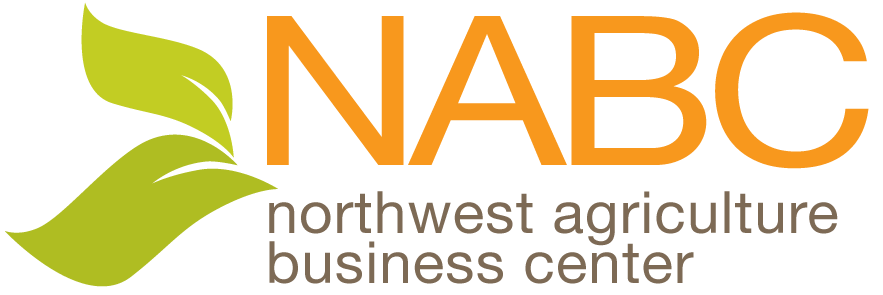Strength Through Diversity: People, Products, Markets
By PSFN’s Communications and Outreach Coordinator, Emma Brewster
On Thursday, Cascade Harvest Coalition hosted the Olympic Peninsula Farm to Table Trade Meeting in Port Townsend. The overwhelming theme of the day was the importance of diversity: diversity of knowledge, experience, markets, and products.
To kick off the event, Dr. Laura Lewis, the new Director of WSU extension services for Jefferson County, delivered a refreshingly scientific keynote address. Dr. Lewis spoke about “agrobiodiversity” and economic development opportunities therein for farmers and members of the local food economy on the Olympic Peninsula.
Much of Dr. Lewis’s presentation drew on the concept of Edge Theory, commonly used in permaculture design, among other applications. Edge Theory asserts that the edges of areas (of biomes, of neighborhoods, of garden plots…) harbor a tremendous amount of diversity, and discusses the desirable resiliency and stability found through such eclecticism. Dr. Lewis offered the example of ecotones: the areas between biomes or environmental regions such as the salty march which separates the grassy dunes from the sea, or the Serengeti savannah which joins the Sahara desert to the central rainforest in Africa. These inter-regions are areas of great biodiversity, abundance, and environmental dynamism, and are less affected by changes which might devastate the environ on either side. Ecotones both result from and indicate a gradient of conditions between zones, such as changing precipitation levels, shifting temperature, or differential access to sunlight.
 Dr. Lewis reminded us that realms between more distinct areas are not just an environmental or biological phenomenon, but that the local food economy on the Olympic Peninsula (and in other regions) is a sort of ecotone itself. Dr. Lewis pointed out that our agricultural system is not simply a linear chain from seed to spoon, but rather there is in fact a large amount of dynamism and potential where players in the food system interact and overlap.
Dr. Lewis reminded us that realms between more distinct areas are not just an environmental or biological phenomenon, but that the local food economy on the Olympic Peninsula (and in other regions) is a sort of ecotone itself. Dr. Lewis pointed out that our agricultural system is not simply a linear chain from seed to spoon, but rather there is in fact a large amount of dynamism and potential where players in the food system interact and overlap.
In these overlapping areas of knowledge and practice, we can choose to ignore or capitalize on our interconnectedness by choosing to either share or withhold knowledge from one another. For instance, a chef who discontinues his order from a local farm, but does not tell the farm what it was that made the chef switch to a different source – quality, price, delivery hiccups – foregoes the opportunity to improve the relationship and the system as a whole because the farm has not learned or grown from the experience. Relationships among different players in the system and the system entirely are strengthened and both see more stability in the long term when knowledge and experience are shared.
The space in the center of the diagram here is the “area of vital connection” across systems. It is this area of diversity and interconnectedness in our own agricultural system that we need to sustain together, and which should be more highly valued and utilized in an effort to strengthen our local agricultural economy.
 With this in mind, as players in the regional food system we can decide to capitalize on the edges that exist within our own systems to identify barriers and weaknesses and to strengthen bonds and systematic resiliency. Interaction between producers and consumers can point out the weaknesses in processing capacity, storage facilities, marketing assistance, and distribution capabilities available. We can then work together to develop milling, meat processing, and distilling facilities; wholesale, direct, collective, and cooperative distribution options; and other infrastructural helps. The more successful we are at preserving interconnectedness, the more stable we’ll all be in the long term. PSFN is proud to be a group that represents each sector in this vital center (consumers, producers, processors, distributors and other service providers). We aim to help share knowledge and information across perceived barriers in an effort to support the regional food economy in the Puget Sound.
With this in mind, as players in the regional food system we can decide to capitalize on the edges that exist within our own systems to identify barriers and weaknesses and to strengthen bonds and systematic resiliency. Interaction between producers and consumers can point out the weaknesses in processing capacity, storage facilities, marketing assistance, and distribution capabilities available. We can then work together to develop milling, meat processing, and distilling facilities; wholesale, direct, collective, and cooperative distribution options; and other infrastructural helps. The more successful we are at preserving interconnectedness, the more stable we’ll all be in the long term. PSFN is proud to be a group that represents each sector in this vital center (consumers, producers, processors, distributors and other service providers). We aim to help share knowledge and information across perceived barriers in an effort to support the regional food economy in the Puget Sound.

A panel discussion also spoke to the idea of diversity and to the benefit to diversifying both products and markets. PSFN Member Kia Armstrong spoke about all the different outlets for Nash’s Organic Produce, and about the pros and cons of each. Nash’s is currently wholesaling about 50% of their products through three or four major wholesalers throughout the Northwest and Canada. Nash’s recently opened its own small grocery store where you can buy all your favorite Nash’s produce and everything else “from olive oil to toilet paper!” as Kia says. In addition to the store, the farm is now more active than ever before at farmers’ markets, and is looking to expand its partnerships with regional institutions. Nash’s currently holds an on-site farmers market at the Olympic Medical Center on Tuesdays. Hospital staff are able to swipe their payroll deduct cards at the market (as opposed to needing cash), which is convenient for shoppers and reliable income for the farm. In its efforts to expand its institutional relationships, Nash’s is also in the process of getting into local schools through the Jefferson and Clallum county Farm to Cafeteria programs, as both schools are working under new local buying initiatives. Kia and Nash’s Organic Produce has partnered with PSFN in the past in marketing their produce to child care centers and to senior meal programs through our Farm to Table Project.
It is institutional markets like these that excite Kathy Pryor of Washington Physicians for Social Responsibility (WPSR) and Heathcare Without Harm (HWH), who also participated in the panel. Kathy is working to gain signatories to the Healthy Food in Healthcare pledge, which commits healthcare institutions to use their enormous purchasing power to improve the health of the food system while also modeling healthy behavior for patients, visitors, and staff.
The healthcare industry is the third largest institutional purchaser of food (after colleges and universities, and elementary schools), and mostly purchases through the same mainline distributors as other, smaller institutional buyers like preschools and senior meal programs. The Healthy food in Healthcare commitment asks hospitals to use their “moral authority” as healthcare providers to support local producers who healthfully and ethically produce their products. By harnessing the purchasing power of the hospitals, WPSR and HWH is able to pave the way for smaller institutions and other local buyers to source their food carefully and locally.
Some local success stories of hospitals partnering with farms include:
- The Olympic Medical Center in Port Angeles was the first hospital in the state to set up an onsite farm stand, and to use produce purchased from that stand in kitchen at least once a week.
- Harrison Medical Center in Bremerton is now directly purchasing whole carcass beef over the winter months, something that Kathy hasn’t seen yet elsewhere.
- United General Hospital in Sedro-Woolley just won second place in the nation for its sustainable food purchasing. Head Chef Chris Johnson made lots of local purchasing relationships with PSFN member farms at our Skagit and Seattle summer Wholesale Markets, and has been able to sustain them, leading to his award.
United General Hospital is currently purchasing 15% of its food for cafeteria and in-patient dining from local producers. The hospital that placed first in the competition (Fletcher Allen Healthcare in Burlington, VT – not far from where I grew up) is at an astounding 40%! So… it can be done!
In contrast to these inspiring local purchasing percentages of 15 and 40%, panel moderator, Katherine Barill of EDC Team Jefferson, reminded us that across the country, only one half of 1% of consumer food is purchased direct from the farmer by the end user. In Jefferson County, that proportion is a relatively impressive 4%. Ms. Barill challenged the audience to envision what might be possible economically for the county and the region if we could raise that number to 20% by 2020? The goal of 20% by 2020 is also the goal set out by the Real Food Challenge, a key partner of PSFN this year, for colleges and universities in the Northwest. The Real Food Challenge also has a food commitment to be signed by college and university presidents and chancellors to similarly harness the purchasing power of colleges and universities.
Kathy sees this region of Washington as a prime candidate for this type of innovative food purchasing at healthcare and other institutions because of the high diversity of farms, as well as the somewhat limited geographic layout: Kathy markets the idea of local food purchasing to hospitals as an essential part of the facilities’ emergency preparedness plan, which all hospital are required to have. It’s an incredible resource to have food at their fingertips (and have the necessary relationships in tact) to feed patients in case of any major disaster which might result in limited transportation or other infrastructural losses.
This panel also discussed the importance of diversifying local products manufactured and sold in our region. Panelist Laura Lawless of the Port Townsend Food Co-op harped on value-added products as one of the most effective ways of ensuring income over the winter months for regional farms. She suggested the alternative value-added markets of health and beauty products, the herb and spice market, and medicinals as the next frontier for local producers. (PSFN is so excited for our soon-to-be-former Operations Manager, Ann Leason, for soon devoting the majority of her time to her own herb farm for health and beauty products, as well as medicinal herbs. Go Ann!)
Laura also gave some great suggestions of value-added products needed in the area:
- Processed meats like salami and sausage
- Frozen convenience foods for busy families – at the Port Townsend co-op they have a frozen Tamale that they can’t keep on the shelves!
- Kale and produce chips
- Salad Dressing
- Pet food
For advice on, and assistance in, entering the value-added marketplace, PSFN and NABC are offering a Transition to Value Added Business Course this winter. The introductory courses in market assessment and business plan development have already passed, but product development classes in a variety of categories remain:
- Value-added Dairy Workshop – Friday, January 27, 2012
- Value-add Floral and Nursery Workshop – Thursday, February 2, 2012
- Value-added Meat Workshop – Monday, February 6, 2012
- Valued Added Prepared Foods – Thursday, February 16, 2012
For more information about these classes, contact Jeff Voltz: jeff@agbizcenter.org / (360) 593-4744
As a final word of advice, Laura said the most important thing you can do as a producer is to take the time to come to the store, demo your product, and tell your story your way to your customers. We at PSFN agree. Telling your story through your brand, your label, and in person is essential.
So in summary, diversity is the key! We should all work to diversify relationships and enhance interconnectedness among different players in the regional food system; producers should diversify their markets (and focus on institutional partnerships) and their products. Diversification of activities across the agricultural continuum will enable all stakeholders to manage risk, which will promote economic development. Diversity is the key to regional economic stability and resilience. So… let’s get talking!
